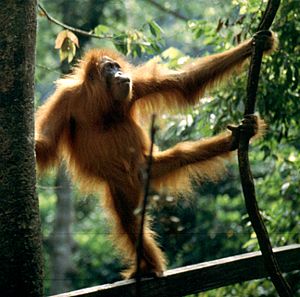Hominid facts for kids

A hominid is a member of the biological family called Hominidae. This group includes all the "great apes," both those alive today and those that are now extinct. Today, this family includes humans, chimpanzees, gorillas, and orangutans.
The word "hominid" has been used in different ways over time. How we classify great apes has changed a few times recently. These changes led to different meanings for the word "hominid." Originally, "Hominidae" only meant humans and their closest relatives. Now, that smaller group is often called Hominina.
Understanding Hominid Terms
It can be a bit confusing because there are many similar words used in primatology, which is the study of primates. Here are some of the main terms:
- A hominoid or ape is a member of the larger group Hominoidea. This includes all apes, like the lesser apes (gibbons) and the great apes.
- A hominid is a member of the family Hominidae. This means all of the great apes: humans, chimpanzees, gorillas, and orangutans.
- A hominine is a member of the subfamily Homininae. This group includes gorillas, chimpanzees, and humans, but it does not include orangutans.
- A hominin is a member of the tribe Hominini. This group includes humans and our closest extinct relatives.
How Scientists Classify Hominids
For a long time, scientists debated whether humans and our early ancestors (like Australopithecines) were different enough from chimpanzees to be in a separate family.
When scientists looked at the physical features and how these creatures lived (their morphology and life style), humans seemed very different. For example, moving from rainforests to open grasslands and woodlands led to bipedalism, which means walking on two feet. Later, hunting and social needs led to bigger brains and the ability to make and use tools. These are big differences between humans and other great apes.
However, when scientists started looking at genetic differences, they found that humans and chimpanzees are very similar. The genetic differences are not big enough to put humans in a completely separate family from the other great apes. Today, genetics is usually the most important way to classify living things.
Many scientists, especially anthropologists (people who study human culture and development), still use the term "hominid" to mean humans and their direct ancestors who walked on two feet.
Images for kids
-
Humans are one of the four living hominid groups.
-
A model of a modern human hominid skull.
-
A fossil hominid exhibit at The Museum of Osteology in Oklahoma City, Oklahoma.
-
A replica of the skull sometimes known as "Nutcracker Man", found by Mary Leakey.
See also
 In Spanish: Homínidos para niños
In Spanish: Homínidos para niños






